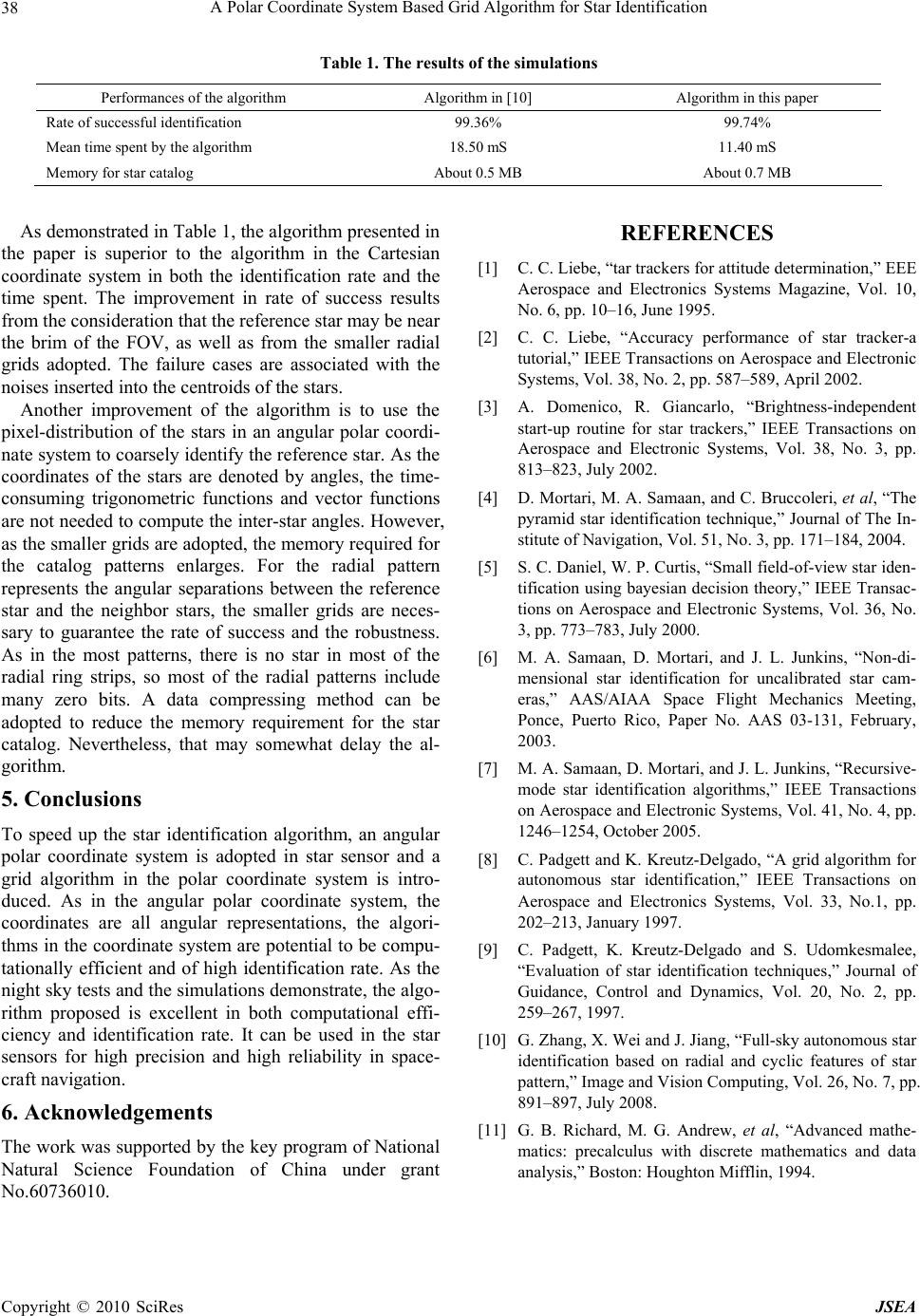
A Polar Coordinate System Based Grid Algorithm for Star Identification
38
Table 1. The results of the simulations
Performances of the algorithm Algorithm in [10] Algorithm in this paper
Rate of successful identification 99.36% 99.74%
Mean time spent by the algorithm 18.50 mS 11.40 mS
Memory for star catalog About 0.5 MB About 0.7 MB
As demonstrated in Table 1, the algorithm presented in
the paper is superior to the algorithm in the Cartesian
coordinate system in both the identification rate and the
time spent. The improvement in rate of success results
from the consideration that the reference star may be near
the brim of the FOV, as well as from the smaller radial
grids adopted. The failure cases are associated with the
noises inserted into the centroids of the stars.
Another improvement of the algorithm is to use the
pixel-distribution of the stars in an angular polar coordi-
nate system to coarsely identify the reference star. As the
coordinates of the stars are denoted by angles, the time-
consuming trigonometric functions and vector functions
are not needed to compute the inter-star angles. However,
as the smaller grids are adopted, the memory required for
the catalog patterns enlarges. For the radial pattern
represents the angular separations between the reference
star and the neighbor stars, the smaller grids are neces-
sary to guarantee the rate of success and the robustness.
As in the most patterns, there is no star in most of the
radial ring strips, so most of the radial patterns include
many zero bits. A data compressing method can be
adopted to reduce the memory requirement for the star
catalog. Nevertheless, that may somewhat delay the al-
gorithm.
5. Conclusions
To speed up the star identification algorithm, an angular
polar coordinate system is adopted in star sensor and a
grid algorithm in the polar coordinate system is intro-
duced. As in the angular polar coordinate system, the
coordinates are all angular representations, the algori-
thms in the coordinate system are potential to be compu-
tationally efficient and of high identification rate. As the
night sky tests and the simulations demonstrate, the algo-
rithm proposed is excellent in both computational effi-
ciency and identification rate. It can be used in the star
sensors for high precision and high reliability in space-
craft navigation.
6. Acknowledgements
The work was supported by the key program of National
Natural Science Foundation of China under grant
No.60736010.
REFERENCES
[1] C. C. Liebe, “tar trackers for attitude determination,” EEE
Aerospace and Electronics Systems Magazine, Vol. 10,
No. 6, pp. 10–16, June 1995.
[2] C. C. Liebe, “Accuracy performance of star tracker-a
tutorial,” IEEE Transactions on Aerospace and Electronic
Systems, Vol. 38, No. 2, pp. 587–589, April 2002.
[3] A. Domenico, R. Giancarlo, “Brightness-independent
start-up routine for star trackers,” IEEE Transactions on
Aerospace and Electronic Systems, Vol. 38, No. 3, pp.
813–823, July 2002.
[4] D. Mortari, M. A. Samaan, and C. Bruccoleri, et al, “The
pyramid star identification technique,” Journal of The In-
stitute of Navigation, Vol. 51, No. 3, pp. 171–184, 2004.
[5] S. C. Daniel, W. P. Curtis, “Small field-of-view star iden-
tification using bayesian decision theory,” IEEE Transac-
tions on Aerospace and Electronic Systems, Vol. 36, No.
3, pp. 773–783, July 2000.
[6] M. A. Samaan, D. Mortari, and J. L. Junkins, “Non-di-
mensional star identification for uncalibrated star cam-
eras,” AAS/AIAA Space Flight Mechanics Meeting,
Ponce, Puerto Rico, Paper No. AAS 03-131, February,
2003.
[7] M. A. Samaan, D. Mortari, and J. L. Junkins, “Recursive-
mode star identification algorithms,” IEEE Transactions
on Aerospace and Electronic Systems, Vol. 41, No. 4, pp.
1246–1254, October 2005.
[8] C. Padgett and K. Kreutz-Delgado, “A grid algorithm for
autonomous star identification,” IEEE Transactions on
Aerospace and Electronics Systems, Vol. 33, No.1, pp.
202–213, January 1997.
[9] C. Padgett, K. Kreutz-Delgado and S. Udomkesmalee,
“Evaluation of star identification techniques,” Journal of
Guidance, Control and Dynamics, Vol. 20, No. 2, pp.
259–267, 1997.
[10] G. Zhang, X. Wei and J. Jiang, “Full-sky autonomous star
identification based on radial and cyclic features of star
pattern,” Image and Vision Computing, Vol. 26, No. 7, pp.
891–897, July 2008.
[11] G. B. Richard, M. G. Andrew, et al, “Advanced mathe-
matics: precalculus with discrete mathematics and data
analysis,” Boston: Houghton Mifflin, 1994.
Copyright © 2010 SciRes JSEA